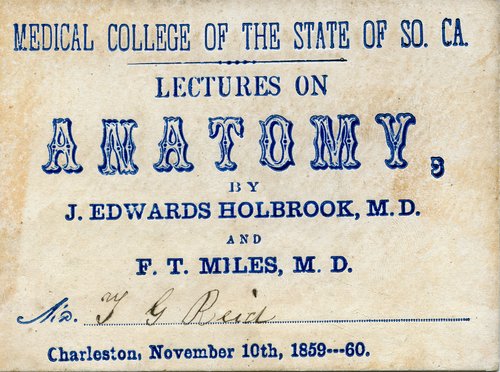
<br/>
John Edwards Holbrook, Professor of Anatomy
<br/>
John Edwards Holbrook was born in Beaufort, South Carolina in December 1794 before his family moved to Wrentham, Massachusetts. He graduated from Brown University in 1815 before enrolling in the medical department at the University of Pennsylvania in 1816. Over the next few years, he continued his medical and scientific studies in Boston, Edinburgh, London, and Paris, where he befriended many leading naturalists of the day. At some point after his graduation from medical school in 1818, Holbrook moved to Charleston. By December 1822, he had opened his practice at the intersection of Tradd and Orange Streets. Holbrook joined the Medical Society on March 1, 1824. He was elected to the Medical College’s professorship of Anatomy at his second meeting on April 12, 1824. He retained his position at the Medical College of the State of South Carolina, where he taught until his retirement in 1860.
<br/>

Holbrook was also a member of the American Philosophical Society, the American Association for the Advancement of Science, and the National Academy of Sciences. In addition to his medical accomplishments, Holbrook was also interested in reptiles, amphibians, and fish. He published
in four volumes between 1836 and 1840. His other works include
Southern Ichthyology; or, a Description of the Fishes Inhabiting the Waters of South Carolina, Georgia and Florida (1847-1848), as well as
Ichthyology of South Carolina (1855-1857). Through his work as a naturalist, he became lifelong friends with Louis Agassiz, the Harvard zoologist who argued that Black people were anatomically different from white.
<br/>
When he retired from teaching in 1860, Holbrook and his wife, Harriott Pinckney Rutledge Holbrook, had significant slaveholdings totaling $10,000. And, although he had extensive ties to New England, he served as a field surgeon for the Confederacy during the Civil War.
When he retired from teaching in 1860, Holbrook and his wife, Harriott Pinckney Rutledge Holbrook, had significant slaveholdings totaling $10,000. And, although he had extensive ties to New England, he served as a field surgeon for the Confederacy during the Civil War.
<br/>
Holbrook died September 8, 1871 while visiting relatives in Norfolk, Massachusetts. He is buried at Magnolia Cemetery in Charleston.
Holbrook died September 8, 1871 while visiting relatives in Norfolk, Massachusetts. He is buried at Magnolia Cemetery in Charleston.
<br/>
(Image Description: Lecture ticket for the Medical College of the State of South Carolina from November 10th, 1859-60. Waring Historical Library, Manuscript Collection, MSS 47.)
